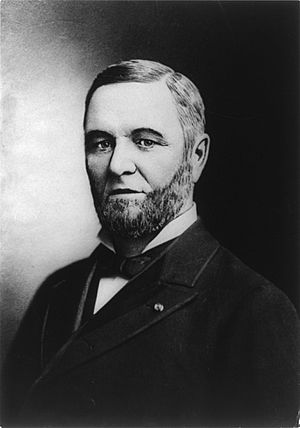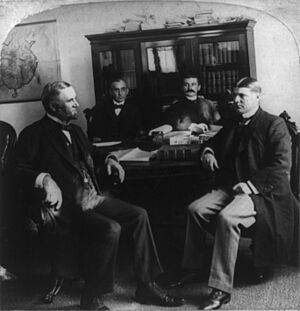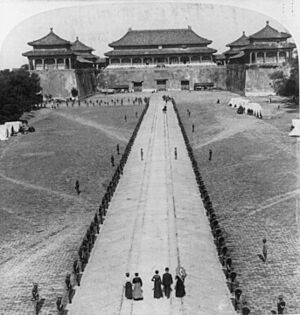Edwin H. Conger facts for kids
Quick facts for kids
Edwin H. Conger
|
|
|---|---|
 |
|
| United States Ambassador to Mexico | |
| In office June 15, 1905 – August 3, 1905 |
|
| President | Theodore Roosevelt |
| Preceded by | Powell Clayton |
| Succeeded by | David E. Thompson |
| United States Minister to China | |
| In office July 8, 1898 – April 4, 1905 |
|
| President | William McKinley Theodore Roosevelt |
| Preceded by | Charles H. Denby |
| Succeeded by | William W. Rockhill |
| United States Minister to Brazil | |
| In office August 9, 1897 – February 6, 1898 |
|
| President | William McKinley |
| Preceded by | Thomas Larkin Thompson |
| Succeeded by | Charles Page Bryan |
| In office December 19, 1890 – September 9, 1893 |
|
| President | Benjamin Harrison Grover Cleveland |
| Preceded by | Robert Adams, Jr. |
| Succeeded by | Thomas Larkin Thompson |
| Member of the U.S. House of Representatives from Iowa's 7th congressional district | |
| In office March 4, 1885 – October 3, 1890 |
|
| Preceded by | Hiram Y. Smith |
| Succeeded by | Edward R. Hays |
| Personal details | |
| Born | March 7, 1843 Knox County, Illinois, U.S. |
| Died | May 18, 1907 (aged 64) Pasadena, California, U.S. |
| Political party | Republican |
| Spouse | Sarah J. Conger nee Pike |
| Profession | Politician, lawyer |
Edwin Hurd Conger (born March 7, 1843 – died May 18, 1907) was an important American figure. He was a soldier in the American Civil War, a lawyer, and a banker. He also served as a congressman for Iowa. Later, he became a diplomat for the United States in other countries. One of his most famous roles was being the top U.S. diplomat in China during the exciting time of the Boxer Rebellion. During this event, he and his family, along with other foreign diplomats, were trapped in Beijing until they were rescued.
Contents
Early Life and Military Service
Edwin Conger was born in Knox County, Illinois, in 1843. He went to Lombard College and finished his studies in 1862. Soon after, he joined the army as a private to fight in the American Civil War. He was part of the 102nd Illinois Volunteer Infantry Regiment. During his service, he showed great bravery and was promoted to captain and later to major.
After the war ended, Edwin decided to study law. He went to Albany Law School and graduated in 1866. He then started his career as a lawyer in Galesburg, Illinois. In 1868, he moved to Dexter, Iowa. There, he became involved in banking, raising livestock, and farming.
Edwin Conger was married to Sarah Pike. She was also from Iowa and was a writer. Sarah Conger was known for her work with the Woman's Christian Temperance Union. She traveled with Edwin to China and later became friends with China's powerful Empress Dowager Cixi.
Political Career in Iowa
Edwin Conger began his political journey in Iowa. He was elected as the treasurer for Dallas County, Iowa, twice, in 1877 and 1879. His success led him to become the Iowa State Treasurer in 1880, and he was reelected for that role in 1882.
In 1884, the current U.S. Representative for Iowa's 7th congressional district decided not to run again. Edwin Conger won the nomination from the Republican Party to take his place. He was elected to the U.S. House of Representatives and served for three terms. While in Congress, he led a committee focused on money and measurements.
Serving as a Diplomat Abroad
In 1890, Edwin Conger left Congress to become a U.S. diplomat in Brazil. This job is now called an ambassador. He served there until 1893. He returned to this position in 1897 when a new Republican president, William McKinley, was elected.
Diplomat in China: The Boxer Rebellion
In 1898, President McKinley appointed Conger as the top U.S. diplomat to China. He represented the United States to the Great Qing Empire. When Conger arrived in China, a violent anti-foreign movement was growing. This group was called the "Boxers" by Westerners.
In June 1900, Boxer fighters gathered in Beijing and surrounded the foreign embassies. This event became known as the Boxer Rebellion. News reports in America wrongly said that Conger and all other foreigners in Beijing were dead. However, Americans and other Westerners had gathered in the Beijing Legation Quarter. They were under siege for 55 days. Finally, an international army of 20,000 soldiers came to rescue them.
After his rescue, Conger returned to the United States in 1901 and was welcomed as a hero. He then went back to China and continued his diplomatic work for several more years, until 1905. His wife, Sarah, became good friends with Empress Dowager Cixi, who was a powerful ruler in China. Sarah Conger often spoke out against Western countries trying to control China's affairs.
Later Diplomatic Roles
In 1905, President Theodore Roosevelt appointed Conger as the Ambassador to Mexico. His time in Mexico was short, lasting only a few months. President Roosevelt then asked him to take on a special mission back in China. This mission was important because the U.S. had strict immigration rules for Chinese people, and there were problems with a railroad project. These issues led to Chinese people boycotting American goods.
However, Conger decided not to accept this new mission and resigned from his post in Mexico.
Edwin Conger passed away in Pasadena, California, on May 18, 1907. He was buried in Mountain View Cemetery in Altadena, California. His death was thought to be caused by a disease he caught while serving in China.



